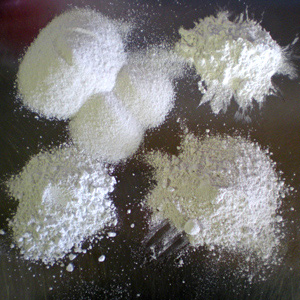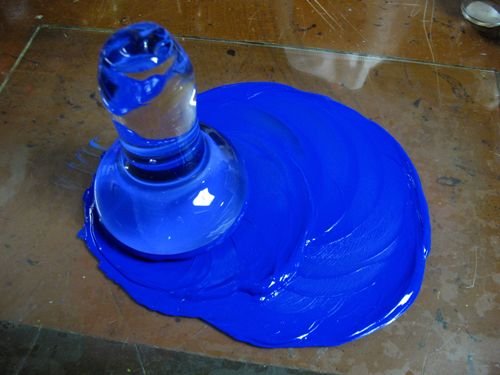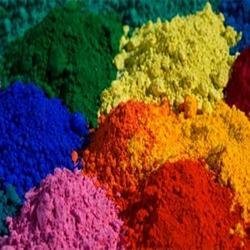Introduction to Pigment
CAUTION!!!
The use of dry pigment powders is a health hazard. Toxic substances used in art may enter the body through ingestion, respiration/aspiration, and absorption through the skin. The affects can be acute or chronic in nature. Exposure can cause brain damage and mental illness as well as physical harm or even death. The best example of this is flake white, a pigment that has been in use for 2000 year. Flake white (basic carbonate white lead) and other materials labeled as hazardous should be used following theses two rules of safety: (1) Only buy it in paint form, never handle or try to implement the raw powder form. (2) After using flake white wash your hands thoroughly making sure to get under the fingernails before touching food.
When learning how to mix your own paints you should always ware rubber gloves and a ventilator mask. A good shower after probably wouldn't be a bad idea either.
A pigment is a finely divided, colored substance that imparts its color effect to another material either when mixed or when applied over it surface. When a pigment is ground into a liquid vehicle to form a paint, it does not dissolve but remains suspended within the liquid. Substances that dissolve are classified as dyes. Pigments have other classifications than just color, when referring to these I will describe them as the pigments properties. Powdered materials that become colorless or nearly colorless in paint are referred to as "inert" a classification that has no reference to the to chemical inertness or stability.

The various methods oil, watercolor, acrylic, ect. differ from one another in the materials with which the color is applied and attached to the ground, the pigments used however are essentially the same. The only exception being a pigment that's suitable for one medium doesn't always work for all.
The 9 things you should look at when buying pigment
- It should be a smooth, finely divided powder
- Should be insoluble in the medium in which it should be used
- Should be able to withstand sunlight without changing its color, under conditions similar to that of your finished painting
- Should not cause and harmful chemical reactions when mixed with anything you plan to use
- Should be chemically inert and unaffected by the materials or its atmosphere
- Should have the proper degree of opacity or transparency to meet the need
- Should be of full strength and contain no added inert or loading ingredients
- Should conform to accepted standards of quality in color of its type
- Should be purchased from a reliable source that can provide information of its origin and quality
Pigments can be classified according to color, use, permanence ect. Though its customary to classify according to origin
A. Inorganic
1. Native Earths : ochre, raw umber, ect.
2. Calcined Native Earths: burnt umber, burnt sienna, ect.
3. Inorganic synthetic colors: cadmium yellow, zinc oxide, ect.
B. Organic
1. Vegetable: gamboge, indigo, madder, ect.
2. Animal: cochineal, indian yellow, ect.
3. Synthetic organic pigments
Inorganic synthetic color made with heat are typically of the highest permanence of all uses, while those requiring delicate or very accurately balanced processing are less. The synthetic counterparts or the red and yellow earths are more brilliant and, if well prepared, superior in all other respects to the native products. In general, pigments derived from natural sources are less permanent than the average synthetic color. The synthetic organic pigments are characterized by a great brilliance and intensity. Many of them are remarkably permanent, but others, particularly the older ones are fugitive and have the defect of bleeding in oils. Many require an additional inert base during manufacturing.

The native earths used as pigments occur all over the world, but there is always some special locality where each is found in superlative form or where conditions have been established which permit its being purified to a greater or more uniform extent than is economically possible elsewhere. Substitutes for French ochre, Indian sienna, ect. are offered for reasons other than the purpose of supplying the best available products. The natural impurities in some red earths are of such a character as to be harmful; therefor the synthetic red oxides are preferred in this case. The impurities within some of the highest grades of ochre and others seldom present these same disadvantages. The synthetic prepared colors of American makes are equal if not superior to any other. Cobalt yellow, cerulean blue, cobalt violet, cobalt green, and Naples yellow are all made in very limited supply almost entirely for artists alone therefor for economic reasons are not produced in some countries. Though European books have described defects in pigments that have long since been overcome by American manufacturing.
Sorry about the late start I got today, hope your enjoying this journey of education as much as I am.
Tomorrow we can go into more detail on this subject, but my eyes hurt from reading and typing lol.
Don't be shy the upvote and resteem doesn't bite ;) but you have to let me know down in the comments if it does bite you.

Interesting series you have going on! Glad you have health warnings cause you never know these days:-P
Yeah people are not always the brightest. As I was writing this I couldn't help but think this might have been where the old all artists are crazy thing comes from. No rubber gloves and ventilators back then lol.
OK. That made me chuckle. Out loud.